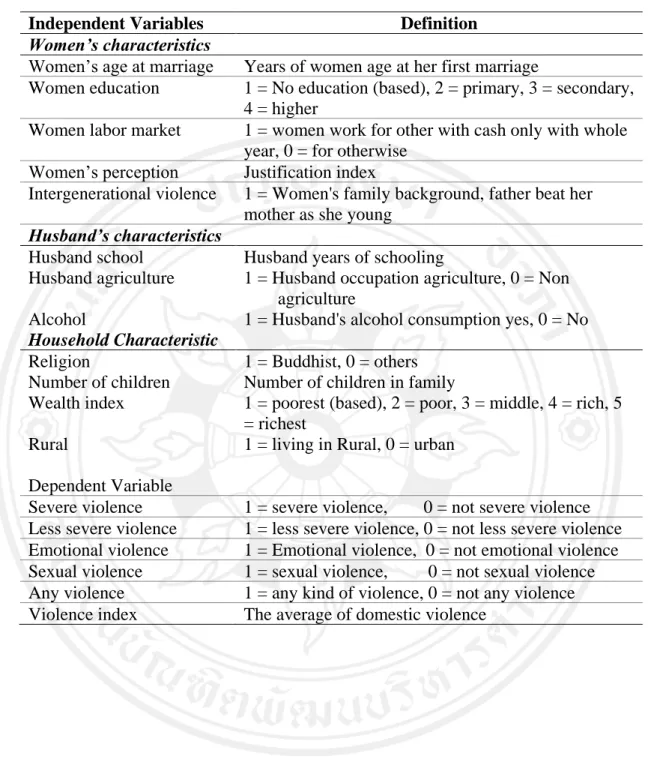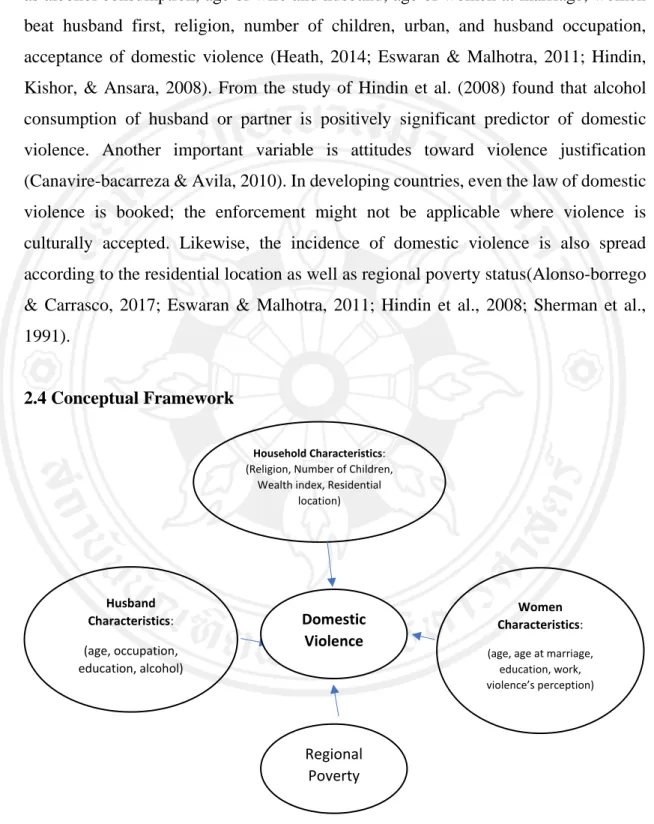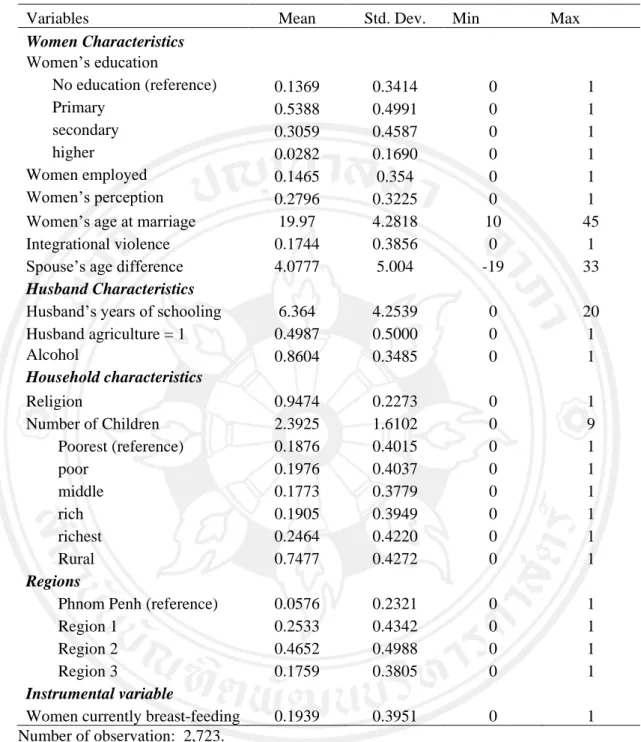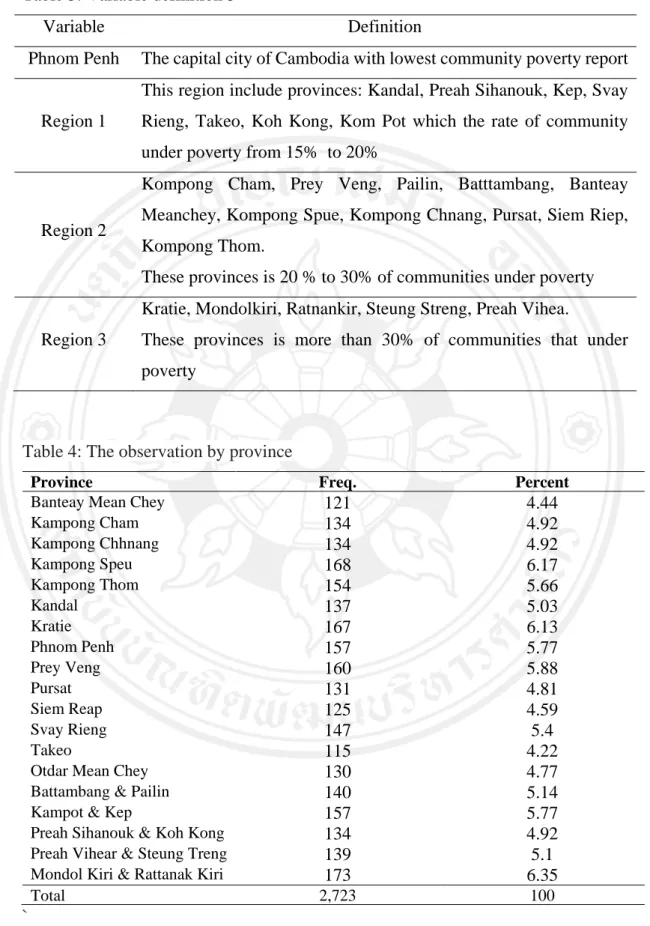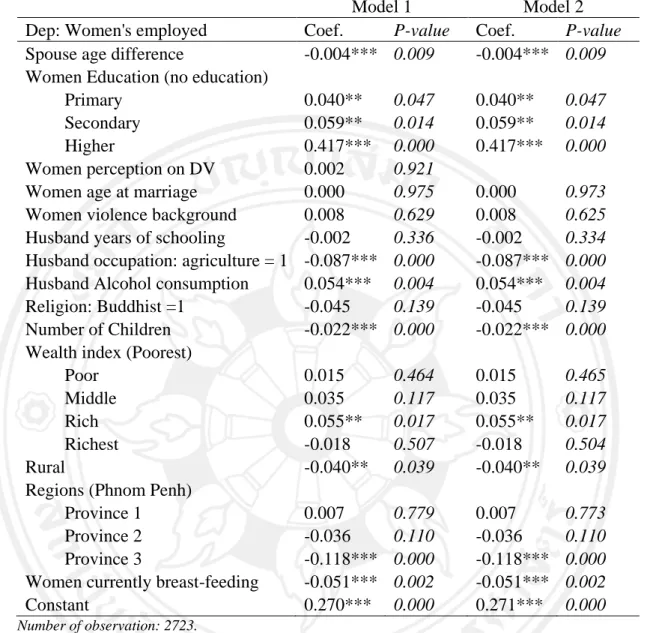This means that employment for women in the labor market has no effect on domestic violence. First of all, I would like to thank my thesis supervisor, Associate Professor Undomsak Seenprachawong from the School of Development Economics of the National Institute of Development Administration (NIDA).

INTRODUCTION
- Introduction
- Objective
- Significance of the Study
- Scope of the Study
From the research on this topic in the context of Cambodia, there are few empirical studies on the determinants of domestic violence. Instead, research on the causality effect between women's labor market participation and domestic violence has not yet been explored.

LITERATURES REVIEW
Domestic Violence and Status of Women’s Employment
Most studies on domestic violence and women's employment ignore the endogeneity problem (Macmillan & Gartner, 1999; Farmer & Tiefenthaler, 1997). Carrasco (2017) further found that there is no evidence to support a negative effect of a woman's employment on the risk of domestic violence when she is employed alone in her family.
Individual and Household Characteristics
There may be an unobservable variable that is correlated with both women's economic status and domestic violence due to women's employment is an endogenous variable, where it is the choice made by a woman or the household as a result of abuse. However, these empirical results are the same in both cases, where they found that increased employment opportunities for women significantly reduce the incidence of domestic violence. It only matters when both spouses are employed, and domestic violence is more likely to occur when only the man is working in the family.
On the contrary, Eswaran & Malhotra (2011) and Alonso-Borrego & Carrasco (2017) found in their research in India and Spain, respectively, that the education of women and men has a very significant negative effect on domestic violence. For an empirical study, Hindin, Kishor, and Ansara (2008) examined the determinant of domestic violence by including the variable of women's history of domestic violence. Their study found that women whose father had ever beaten their mother were more likely to be beaten by their current husband.
Bowlus and Seitz (2006) provide empirical evidence on intergenerational intimate partner violence in Canada, with men with a violent background having a strongly positive significance for domestic violence, while women with a violent background are less likely to be statistically significant. A recent study in Spain by Alonso-borrego and Carrasco (2017) found that household income does not significantly reduce the incidence of violence. Analytical studies of domestic violence in 10 countries published by DHS in an analytical report in 2008 found that households in higher wealth quintiles were less likely to experience violence in three countries: Bolivia, Moldova and Zimbabwe.
Other Key Characteristics
METHODOLOGY
Data
Model Specification
The key issue here in this regression, however, is that women's employment status could be the endogenous independent variable. Thus, the ordinary least squares (OLS) model and the binary probit model lead to bias and inconsistency estimation due to the correlation between the error term 𝜀𝑖 and the explanatory variable women's employment status. Similarly, Farmer & Tiefendthaler (2004) found that domestic violence in America has a significant effect on women's employment.
In addition, Tolman & Wang (2005) also found that spousal violence affected women's annual work hours in the state of Michigan. An omitted variable leading to endogenous for both women's employment status and family violence is social norm. This first step is the regression between women's employment and the instrument variable Ζ1 and the control variable Ζ2, which are overlapped in equation (1).
The second stage estimates the interesting dependent variable of domestic violence from the instrumental variable of women's access to the labor market and another exogenous variable in the same way as the first stage. The two-stage least square procedure must find the instrumental variable (IV) Ζ1 corresponding to the endogenous variable women's employment status. Many previous literatures in the context of domestic violence and women's work status used instrumental variables, such as the cluster average of women's work status, the number of household members, or the type of family, as an instrumental variable for women's employment status (Jana & Klasen, 2017). ; Bhattacharyya, Chhachhi and Bedi, 2009).
Descriptive Statistic
- Women’s Employment Status and Domestic Violence
- Independent Variables
- Instrumental Variables
Less severe violence has the second highest violence prevalence in Cambodia, with 11.1% of women reported as victims of violence. The number of women entering the labor market is defined as working outside the home, cash income, and working all year round. It is assigned as 1 for women entering the labor market and 0 for women who work in the home or are self-employed.
The variation of violence by status of working women is not much difference, except for the emotional violence, which is only 15.91% of the total number of women entering the labor market, compared to 21.42% of women who do not enter the labor market. Overall, for domestic violence, the women who do not participate in the labor market are more likely to be abused, since its rate of violence is higher than women who participate in the labor market. 13.8% of the total female sample size are uneducated and only 2.9% of women have a secondary or higher education.
In terms of women's labor force participation, only 14.7% of the total number of women are in the labor market, which shows that women's labor force participation in the formal sector is quite low. The variable of intergenerational violence, the family background of domestic violence in women, is whether her father ever hit her mother or not. What we need to take into account is that women who experience domestic violence may be affected.
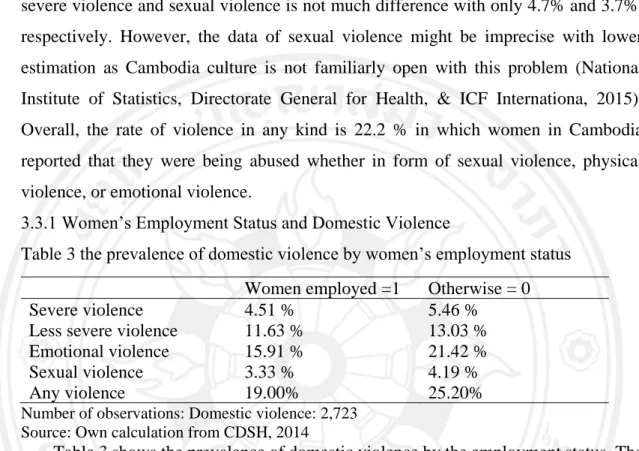
RESULT
Ordinary Least Square (OLS) and Marginal Effect of Probit Model
In contrast, intergenerational violence is a strongly positive predictor of domestic violence and is robust across all regressions. A connection to this may be due to the female perspective of domestic violence being socially acceptable (Hindin, Kishor, & Ansara, 2008). For the male alcohol consumption variable, it is strongly positive for domestic violence with statistical significance.
Also, households that believe in the Buddhist religion tend to have more cases of domestic violence than other religions. The wealth index coefficients are negative and statistically significant, while households in rural areas are less likely to have incidents of domestic violence compared to urban areas. To analyze in depth whether the significance of coefficients changes with the type of domestic violence, the regression in Table 5 in Appendix B shows the probability of women ever experiencing domestic violence under severe violence, less severe violence, emotional violence and sexual violence. violence.
Likewise, for these different types of violence, the results in terms of the sign and magnitude of the coefficients are comparable to regressions 1 and 2 on total domestic violence. For example, women's perception of domestic violence has a positive effect on domestic violence, especially emotional violence. However, there is a lack of statistically significant numbers of women entering the labor market for all forms of domestic violence.
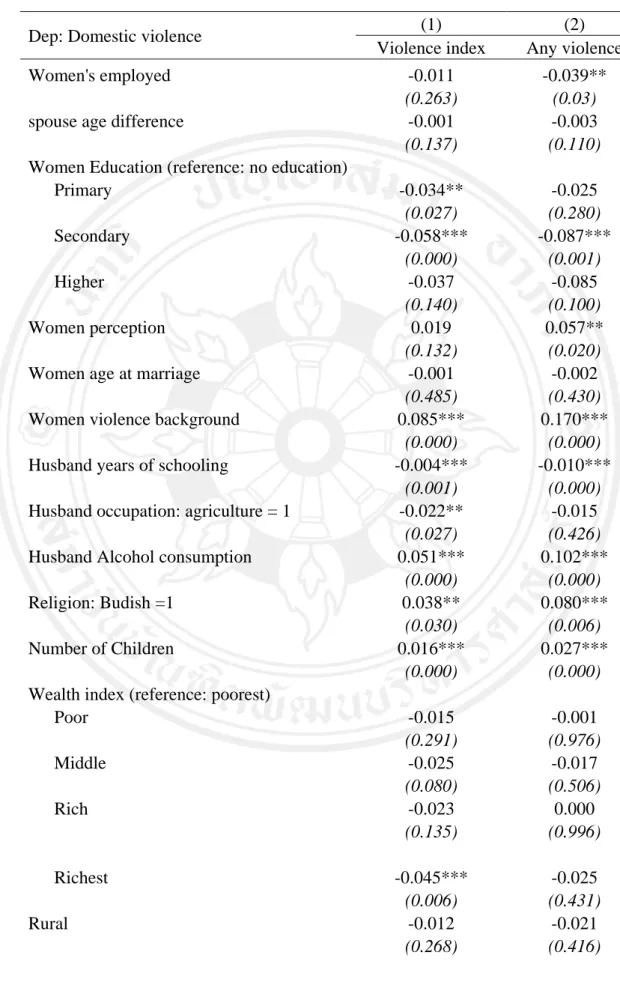
Instrumental Variable Estimation
The instrumental variable "currently breastfeeding" is expected to have a statistically significant effect on women's access to the labor market, and it should also be a strong instrumental variable, but it does not directly affect domestic violence. This result is consistent with the study of Lenze and Klasen (2017), which finds that employment of women is not conclusive regarding domestic violence. According to the size of the coefficients of a woman's level of education, the incidence of domestic violence is lower when her education is higher.
This result contradicts the previous study by Eng et al., (2010) in the case of Cambodia, which states that female education has no effect on domestic violence. In contrast, both models find that there is no clear support for men's educational effect on domestic violence. For women's perceptions of domestic violence, which is included in the specification 1 model, the coefficient is a positive sign, where a one percent increase in women's tolerance of domestic violence will increase family violence by an average of 1.7 percent increase, ceteris paribus, but less statistically significant in the case of domestic violence. this case.
Based on the coefficient of both models, the statistic shows that the prevalence of domestic violence of Buddhist religions is 5.8% higher than other religions with 5% statistical significance, considering other variables constant. This result can be interpreted that the better standard of living of the family will significantly reduce the incidence of domestic violence. For regional poverty status, counties with a poorer community also have higher rates of domestic violence as its coefficient is positive and 5% of statistical significance.
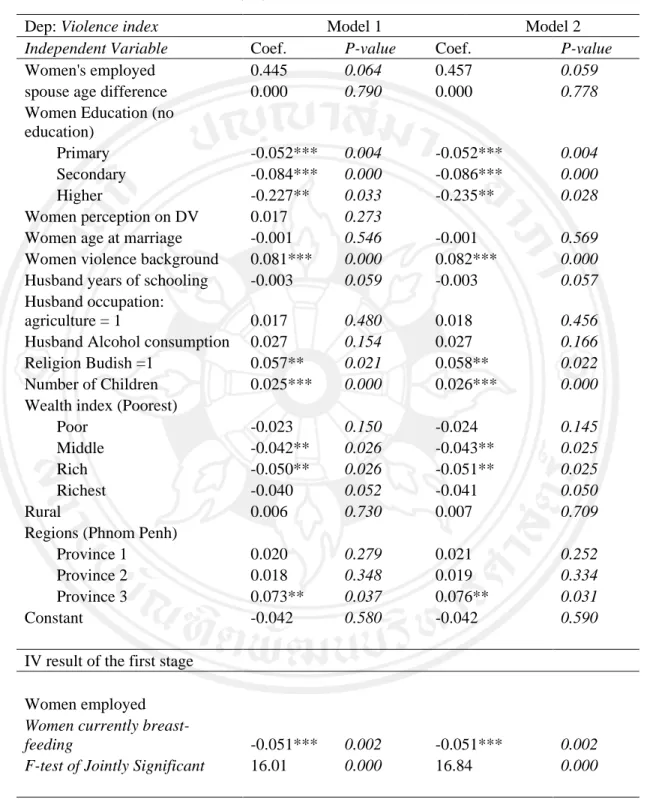
CONCLUSION
Conclusion
Policies Discussion and Limitation of the Study
When women's initial bargaining power status increases, they may be able to work in high-skilled labor with higher incomes and finally break free from domestic violence. Finally, the result of this study also shows that any policy that reduces domestic violence today can also affect the long-term generation. Due to the limitation of suitable instrumental variable, more precision of IV is needed for future study on the relationship between women's employment and domestic violence.
While the data of this study cannot focus on more details of the interaction term between the variables of employment and women's educational level, this study cannot separate the factor of domestic violence according to the level of women's bargaining power. Male Response, Bargaining or Reducing Exposure?: Women's Work Status and Physical Spousal Violence in India. Domestic violence against women in Cambodia: husband control, frequency of spousal conversation, and domestic violence reported by Cambodian women.
Women's access to labor market opportunities, control of household resources and domestic violence: evidence from Bangladesh. Serious violence 1 = serious violence, 0 = not serious violence. Less serious violence 1 = less serious violence, 0 = not less serious violence Emotional violence 1 = Emotional violence, 0 = not emotional violence Sexual violence 1 = not sexual violence, sexual violence violence Any violence 1 = any type of violence, 0 = not any violence not Violence Index The average of domestic violence.
